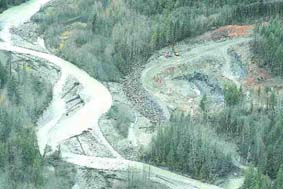Private power industry is booming in B.C., but is that a good thing?
 Gordon Campbell wasn’t kidding when he warned that the future of B.C. was at stake in the last election – or at least its energy future.
Gordon Campbell wasn’t kidding when he warned that the future of B.C. was at stake in the last election – or at least its energy future.The fate of a booming clean-energy industry worth up to $14-billion hung in the balance as taxpayers headed to the polls May 12.
So did the fate of B.C. Hydro. And the power bills almost everyone pays each month.
During the campaign, the NDP had promised to slap a moratorium on private-sector run-of-river power companies if they won.
A Liberal win would mean full-steam ahead for companies like Plutonic Power Corporation, purveyors of a controversial $4-billion, 1,027-megawatt proposal on the Bute Inlet north of Powell River that has environmentalists screaming about “pristine wilderness” being despoiled and 17 streams and rivers being muddied.
With Gordon Campbell’s Liberal victory, Plutonic stock exploded for a 21-per-cent gain on the post-election morning of May 13, reaching market capitalization of about $170 million. Company shares had surged from a low of $2.08 on May 1 to a high of $3.81.
One Plutonic shareholder on the investor website Stockhouse.com summed the action up like this: “Good to see BC stays Liberal, dam tree hugging Ndp’ers are bad for business … lol.” So were they popping champagne corks at Plutonic’s Vancouver headquarters on May 13 as company stock rocked? “No,” spokesperson Elisha McCallum says flatly.
McCallum is one of a number of ex-B.C. Hydro employees and former high-level Liberal party staffers now working for Plutonic.
“We were hopeful [for a Liberal win] and very supportive of the party,” she acknowledged last week. “There was a sense of relief the day after the election.” That relief was shared by the entire industry, says Steve Davis, head of the Independent Power Producers Association of B.C., which represents 320 IPPs.
With the Liberal win and a pending B.C. Hydro energy-acquisition plan due in July, there was a potential for $5 billion in direct IPP investment – on top of $5 billion for existing projects and further billions in indirect investment, Davis told The Province.
NDP energy critic John Horgan says the biggest election victory May 12 didn’t go to Gordon Campbell, star rookie Liberal MLA Kash Heed or even upset Independent winner Vicki Huntington.
“It [went to] Plutonic,” Horgan said. “Now they’re set to go into Bute Inlet and do a $4 billion project that will lead to billions in revenue – and all for stakeholders and Liberal insiders.”
Project critics like the Raincoast Conservation Society’s Chris Genovali say that with cumulative damage, the Bute proposal could be as intrusive as a giant dam.
But as McCallum and industry supporters point out, environmentalists don’t all oppose the projects. Some prominent voices, such as Tzeporah Berman of PowerUP Canada, have come out in support of IPP projects as a valuable expansion in renewable power.
Still, NDP environment critic Shane Simpson insists the Liberal IPP push is unleashing “a gold-rush mentality.”
“There is phenomenal wealth to be made and the provincial government is prepared to set aside the environment,” Simpson says.
Dr. John Nyboer, a Simon Fraser University renewable-energy and climate-change expert, says he wouldn’t label B.C.’s sprouting IPP industry an “exorbitant” gold rush – but he notes that as in any gold rush, anyone can try to hop aboard the IPP gravy train.
“It’s hard to keep track of how many IPPs there are in B.C.,” Nyboer says. “You can put a single solar-power cell on the roof and register [as an IPP].”
Nyboer says investment in renewable energy has skyrocketed in the last 10 years, and especially since 2006 in B.C.
But alternative-energy sources cost more to develop than traditional sources, so hydro ratepayers pay tariffs to “level the playing field.”
Nyboer points to Germany, a world leader in IPP development that also tops Europe for electricity prices. “Going renewable is an investment,” he says. “It may serve Germany well, depending on what you see happening with tomorrow’s energy supply.”
In other words, if world governments unify for tough carbon-emission restrictions, renewable energy leaders like Germany and B.C. could corner power markets.
But with the current global economic slump, B.C.’s government may have locked 20- to 40-year IPP energy purchase agreements (EPAs) in too high, says Horgan.
“B.C. Hydro recognizes the industrial load is going in the toilet,” he says. “Every time a mill closes, energy demand decreases.”
Horgan says B.C. ratepayers are already on the hook for about $30 billion in “unfunded liabilities” in EPAs.
In the worst-case scenario, B.C. Hydro will “be forced” to buy too much electricity from IPPs at premiums of up to $125 a megawatt, when they can produce it for $50 a megawatt. Demand will continue to decrease and power will be dumped to the U.S. for $50 or less a megawatt.
“Why buy high and sell low?” Horgan says. “If the trend line continues, the costs to ratepayers will be enormous.”
B.C. Hydro could even go under, he warns.
“The shareholders in these IPP companies will be rubbing their hands together – and people with electric heat are going to be rubbing their hands to stay warm, because they won’t be able to heat their homes.”
Blair Lekstrom, B.C.’s Minister of Energy and Mines, disputes the NDP’s numbers. He says he believes the existing IPP contract commitment for B.C. ratepayers is about $21 billion.
But he admits that number could jump to as much as $60 billion with B.C. Hydro decisions due this summer.
Source: Sam Cooper - The Province
You can return to the main Market News page, or press the Back button on your browser.

